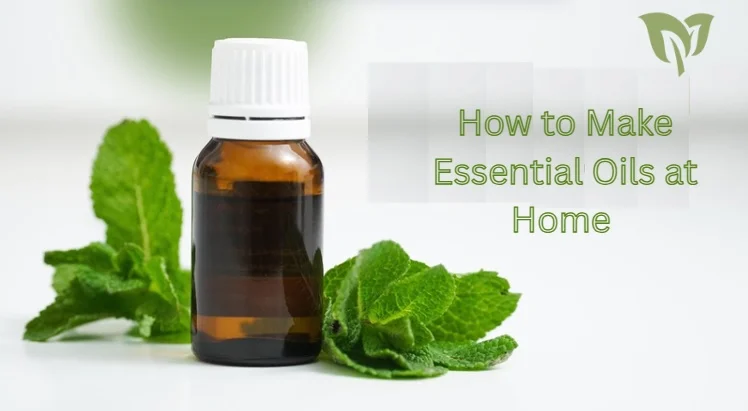Essential oils have won massive recognition for their aromatherapy blessings, skincare makes use of, and natural recuperation homes. But have you ever been puzzled over How to Make Essential Oils? With the proper tools and strategies, you could easily extract extraordinary vital oils from herbs, flowers, and spices. Making your very own oils guarantees purity, affordability, and customization, especially if you’re obsessed with health.
In this manual, we’ll explore diverse methods to make vital oils, the materials required, hints for a garage, and the great vegetation for oil extraction. Whether you are a beginner or a DIY enthusiast, this step-with the aid-of-step guide will assist you master the art of essential oil distillation certainly and successfully.
Table of Contents
What Are Essential Oils?
Essential oils are fantastically focused plant extracts received thru special methods like steam distillation, cold pressing, or solvent extraction. They seize the plant’s natural fragrance, taste, and restoration homes.
- Lavender: Used for rest and sleep.
- Peppermint: Aids in digestion and energy.
- Tea Tree: Fights acne and skin infections.
Methods on How to Make Essential Oils
There are three essential methods for extracting essential oils:
Steam Distillation (Most Common)
Steam distillation is the most popular method used to extract crucial oils from plant life, leaves, and roots.
Materials Needed
- Distillation package (glass or stainless-steel)
- Fresh or dried plant fabric
- Water
- Heat supply (stove or hot plate)
- Ice for condensation
Step-by using-Step Instructions
- Place the plant material in the distillation flask.
- Add water to the flask until it covers the plant base.
- Heat the mixture lightly till steam is produced.
- The steam incorporates the essential oil through a condenser.
- The condensed liquid incorporates oil and water (hydrosol).
- Separate the oil using a separator funnel.
Pro Tip: Use clean plant fabric for higher oil yield.
Cold Pressing (Best for Citrus Oils)
This approach is ideal for extracting oils from citrus culmination like orange, lemon, and bergamot.
Process
- Peel the fruit skin carefully.
- Grate or mash the peels to launch oil.
- Press or squeeze using a mechanical press or blender.
- Strain the pulp and separate the oil.
Note: This technique doesn’t involve heat, so it preserves the oil’s integrity.
Solvent Extraction (For Delicate Flowers)
Used for jasmine, tuberose, and rose, which can be too sensitive for steam.
How It Works
- Mix plant petals with a solvent like ethanol.
- The solvent dissolves the plant’s fragrant compounds.
- The aggregate is then evaporated, leaving in the back of vital oil.
Caution: Not ideal for novices due to chemical coping with.
Best Plants for Making Essential Oils
Here’s a desk of the only plants for critical oil extraction and their key blessings:
| Plant Name | Oil Extracted | Key Benefits |
| Lavender | Lavender Oil | Relaxation, sleep, anxiety |
| Peppermint | Peppermint Oil | Digestion, mental clarity |
| Tea Tree | Tea Tree Oil | Anti-acne, antifungal |
| Lemon | Lemon Oil | Detox, air purification |
| Eucalyptus | Eucalyptus Oil | Cold relief, respiratory health |
| Rosemary | Rosemary Oil | Memory, hair growth |
| Chamomile | Chamomile Oil | Calmness, skin-soothing |
Tip: Always select organically grown flowers for the best oils.
How to Store Your Homemade Essential Oils
Proper garage is vital to keep efficiency and shelf existence.
Storage Tips
- Use darkish glass bottles (amber or cobalt blue).
- Store in a cool, darkish area.
- Label with date and sort of oil.
- Keep away from sunlight and warmth.
Shelf existence varies from 1-three years relying on the oil.
Safety Precautions Before Use
Before applying your DIY crucial oils:
- Dilute with carrier oils (coconut, jojoba, olive).
- Conduct a patch test before use.
- Avoid ingestion until suggested by means of a healthcare expert.
- Keep away from children and pets.
Bonus DIY Recipes
1. Lavender Relaxation Oil
- 10 drops lavender oil
- 2 tbsp coconut oil
- Mix and massage before sleep.
2. Hair Growth Booster
- 5 drops rosemary oil
- 2 tbsp castor oil
- Apply to the scalp and leave overnight.
3. Immune Support Blend
- 5 drops eucalyptus
- 5 drops lemon
- Diffuse in your private home or office.
Benefits of Making Essential Oils at Home
- Cost-powerful – No want to shop for highly-priced business oils.
- Custom blends – Personalize consistent with your desires.
- Purity manage – No additives or preservatives.
- Eco-pleasant – Sustainable DIY procedure.
- Therapeutic advantages – Mental readability, skin health, sleep are useful resources.
- Creative outlet – Great interest for health lovers.
- Gift-worthy – Make custom oils for friends and family.
Summary
This comprehensive guide explains how to make important oils at home using steam distillation, cold pressing, and solvent extraction. Learn the satisfactory flowers to use, safety hints, and storage suggestions. DIY critical oil extraction is price-powerful, healing, and empowers you to create pure, natural wellbeing blends out of your kitchen.
Frequently Asked Questions (FAQs)
Can I make crucial oils without a distillation kit?
Yes, you can use a DIY pot technique with a heat-secure bowl, lid, ice, and pot to simulate distillation, even though the yield can be decreased.
How a good deal of plant fabric is needed for crucial oils?
It takes a large quantity of approximately 30–50 lbs of plant to make just 15 ml of oil, depending on the kind of plant used.
How do I know if the critical oil is natural?
Pure oils are non-greasy, strongly aromatic, and don’t incorporate introduced colorations or chemical substances. Homemade oils give you full purity control.
What carrier oils ought to I use for dilution?
Common carrier oils include coconut oil, jojoba oil, olive oil, and candy almond oil, which might be skin-secure and moisturizing.
